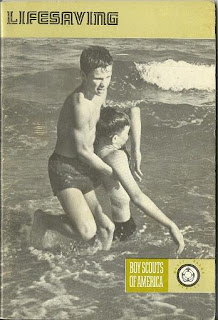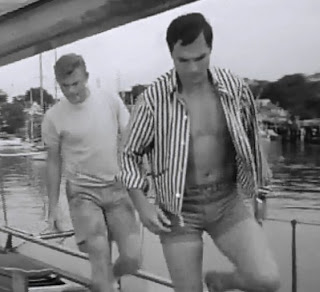
In
I Was a Teenage Frankenstein (1957), #5 on my list of the
Top Horror Movies of the 1950s, Whit Bissell plays an obviously gay Dr. Frankenstein who reads of a high school track team dying in a plane crash, exclaims with homoerotic ardor, "All those fine athletic bodies gone to waste," and hustles out to the cemetery to collect the choicest parts.
The resulting creature is not the groaning, green-faced slug of the Universal picture, but a teenage hunk with the "hands of a wrestler" and the "legs of a football player."
Producer Herman Cohen denies that there was anything special about Gary Conway, hired to play the monster; they just went down to Muscle Beach and grabbed the nearest hunk. But surely it is no coincidence that Gary was studying art at UCLA (a gay-coded major) and posing for the proto-gay magazine
Physique Pictorial.
Gary was actually heterosexual (he married in 1958), or, according to the rumor mills, bisexual, but being an art student, a model in publications aimed at at gay men, and a bodybuilder marked him as "gay."
His Monster has a hideously disfigured face but a beautifully sculpted body, displayed as he lift weights, shirtless (Dr. Frankenstein insists that "our main concern is your physique!"). But when he discovers that he has been constructed out of the stray body parts of dead athletes, he begins to cry. The doctor muses, "We have a very
sensitive teenager on our hands.
Sensitive, code for gay, was not part of the master plan, and comes as an unwelcome surprise.
To remedy the problem of his deformed face, the boy monster and the doctor go shopping for a new one. They park at a lover's lane, an oddly incongruent same-sex couple amid the heterosexual teens necking to big-band music. One wonders why they don't just grab a teen hunk from the locker room. Evidently, they need someone who has engaged in heterosexual practice to give the monster a heterosexual face." So they unglue a blond prettyboy from his girlfriend's lips and take him back to the lab to become a face donor.
But even after the operation, the boy monster is not a man: he can't stop staring at his image in the mirror and stroking his cheeks. "Quite handsome!" Dr. Frankenstein agrees. "Quite, quite handsome!" Of course, he is not really looking at his own face; he is admiring the beauty of the blond they harvested, that is, expressing homoerotic desire.
He is still a monster, not because he is violent or disfigured, but because he has failed to express the heterosexual desire necessary to become a real boy. The film ends quickly and ludicrously when Dr. Frankenstein decides to disassemble the boy, ship the parts to England, and reassemble them there. The boy naturally disapproves, and feeds Dr. Frankenstein to the alligators that conveniently live in a pit beneath the house. Then he is accidentally electrocuted,dying because he cannot live. There is no place for a "sensitive" teenager who admires male beauty in the 1950s.
During the 1960s, Gary had guest spots on nearly every
Swinging Bachelor Detective drama and starred in
Burke's Law (1963-65), as the assistant (but apparently not the boyfriend) of debonair detective Burke (Gene Barry).
In the late 1960s, he appeared on one of my favorite sci-fi programs,
Land of the Giants (1968-70), as Steve Burton, pilot of a spaceship that crash-lands on a planet where everybody is. . .well, a giant. Steve never took his shirt off, but at least he didn't display any heterosexual interest, and he sometimes buddy-bonded with one of the male castaways, Mark (Don Matheson), who became a close friend in real life.
During the 1970s and 1980s, he continued to act, as well as write (three covertly homoerotic
Man-Mountain movies, including
American Ninja and
Over the Top), but he was increasingly involved in his first passion, art. He also studied architecture and became an accomplished violinist, performing at the Hollywood Bowl. And, lest anyone forget that he still had a spectacular physique, he posed nude for
Playgirl.
If that wasn't enough to keep the multitalented performer busy, he bought a ranch in California, converted it to a vineyard, and developed his own wines. And he wrote and illustrated
The Art of the Vineyard.
 Someone asked for a complete list of all the celebrities I met in Los Angeles from 1985 to 1990.
Someone asked for a complete list of all the celebrities I met in Los Angeles from 1985 to 1990.  I met Merritt Butrick in 1988, when he was playing a muscular hustler who wreaks havoc on an older man's life in the theatrical play Kingfish.
I met Merritt Butrick in 1988, when he was playing a muscular hustler who wreaks havoc on an older man's life in the theatrical play Kingfish. 















































